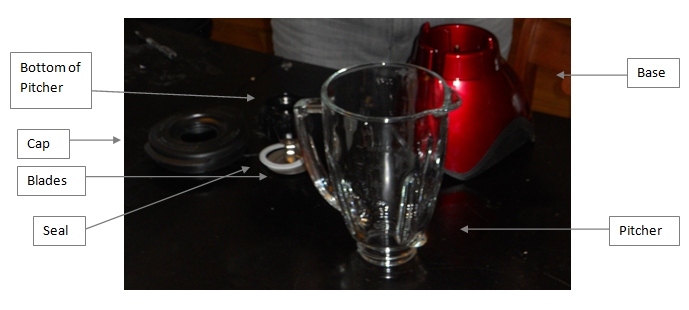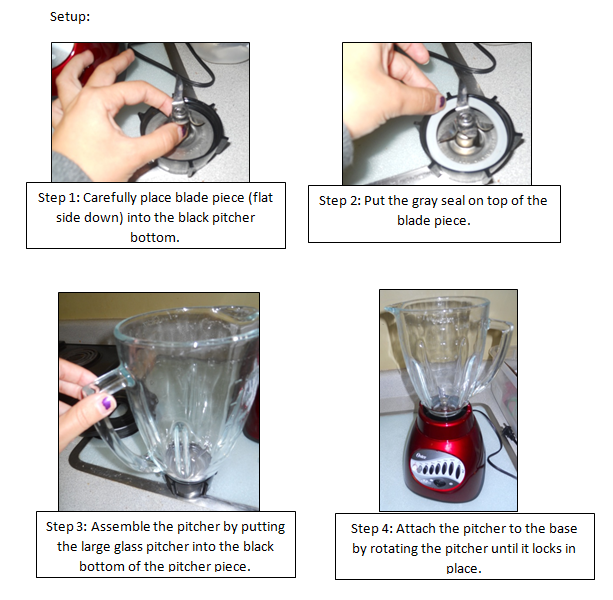Blender 2
From DDL Wiki
(→Stakeholders) |
(→Bill of Materials) |
||
| Line 2: | Line 2: | ||
==Bill of Materials== | ==Bill of Materials== | ||
| + | |||
| + | ===List of Components=== | ||
| + | |||
| + | {| class="wikitable" border="1" | ||
| + | |- | ||
| + | ! Part Number | ||
| + | ! Name | ||
| + | ! Quantity | ||
| + | ! Mass (g) | ||
| + | ! Function | ||
| + | ! Material | ||
| + | ! Manufacturing Process | ||
| + | ! Image | ||
| + | |||
| + | |- | ||
| + | | 1 | ||
| + | | Bottom Cover Screws | ||
| + | | 2 | ||
| + | | <1 | ||
| + | | Join bottom and top covers | ||
| + | | Steel | ||
| + | | Cold forming, Thread rolling | ||
| + | | -- | ||
| + | |- | ||
| + | | 2 | ||
| + | | Fan Bracket Screws | ||
| + | | 2 | ||
| + | | <1 | ||
| + | | Join fan bracket to bottom cover | ||
| + | | Steel | ||
| + | | Cold forming, Thread rolling | ||
| + | | -- | ||
| + | |- | ||
| + | | 3 | ||
| + | | Spring | ||
| + | | 2 | ||
| + | | <1 | ||
| + | | Push motor brushes into rotor | ||
| + | | Metal | ||
| + | | Extrusion, coiled | ||
| + | | -- | ||
| + | |- | ||
| + | | 4 | ||
| + | | Motor Brush | ||
| + | | 2 | ||
| + | | <1 | ||
| + | | Conduct electricity to rotor | ||
| + | | Graphite | ||
| + | | Forming, Sintering | ||
| + | | -- | ||
| + | |- | ||
| + | | 5 | ||
| + | | Fan Blade | ||
| + | | 1 | ||
| + | | 31 | ||
| + | | Cool motor coils | ||
| + | | Steel | ||
| + | | Stamping | ||
| + | | -- | ||
| + | |- | ||
| + | | 6 | ||
| + | | Fan Washer | ||
| + | | 1 | ||
| + | | <1 | ||
| + | | Distribute load to motor shaft | ||
| + | | Steel | ||
| + | | Stamped | ||
| + | | -- | ||
| + | |- | ||
| + | | 7 | ||
| + | | Fan Nut | ||
| + | | 1 | ||
| + | | <1 | ||
| + | | Secure Fan Blade and Fan Washer to motor shaft | ||
| + | | Steel | ||
| + | | Cold forming, Threaded | ||
| + | | -- | ||
| + | |- | ||
| + | | 8 | ||
| + | | Bottom Cover | ||
| + | | 1 | ||
| + | | 158 | ||
| + | | House motor and electronics | ||
| + | | Plastic | ||
| + | | Injection Molding | ||
| + | | -- | ||
| + | |- | ||
| + | | 9 | ||
| + | | Electrical Cord | ||
| + | | 1 | ||
| + | | 50 | ||
| + | | Provide power to blender from electrical socket | ||
| + | | Steel | ||
| + | | Cold forming, Thread rolling | ||
| + | | -- | ||
| + | |} | ||
==Stakeholders== | ==Stakeholders== | ||
Revision as of 12:43, 26 January 2011
Contents |
Executive Summary
Bill of Materials
List of Components
| Part Number | Name | Quantity | Mass (g) | Function | Material | Manufacturing Process | Image |
|---|---|---|---|---|---|---|---|
| 1 | Bottom Cover Screws | 2 | <1 | Join bottom and top covers | Steel | Cold forming, Thread rolling | -- |
| 2 | Fan Bracket Screws | 2 | <1 | Join fan bracket to bottom cover | Steel | Cold forming, Thread rolling | -- |
| 3 | Spring | 2 | <1 | Push motor brushes into rotor | Metal | Extrusion, coiled | -- |
| 4 | Motor Brush | 2 | <1 | Conduct electricity to rotor | Graphite | Forming, Sintering | -- |
| 5 | Fan Blade | 1 | 31 | Cool motor coils | Steel | Stamping | -- |
| 6 | Fan Washer | 1 | <1 | Distribute load to motor shaft | Steel | Stamped | -- |
| 7 | Fan Nut | 1 | <1 | Secure Fan Blade and Fan Washer to motor shaft | Steel | Cold forming, Threaded | -- |
| 8 | Bottom Cover | 1 | 158 | House motor and electronics | Plastic | Injection Molding | -- |
| 9 | Electrical Cord | 1 | 50 | Provide power to blender from electrical socket | Steel | Cold forming, Thread rolling | -- |
Stakeholders
Buyer (for restaurant/smoothie bar use):
- Inexpensive
- Reliable/long product lifespan
- Safe
- Energy efficient
User (restaurant/smoothie bar employee):
- Safe
- Blades should lock into place safely and should not spin when at risk of cutting the user.
- User should not be at risk of electric shock.
- Easy to clean
- Lightweight
- Blends quickly and to the desired consistency without need to shake or manually stir contents
- Different speed functions for different uses
- Crushes ice quickly and effectively
- Simple operation and assembly
- Pours without making a mess
- Contents do not spill out of top during use
- Quiet operation
- Easy to assemble
- Stable, difficult to accidentally knock down
- Sturdy, won’t break if dropped
Home user (Same needs as restaurant user and buyer with the following additional needs):
- Visually appealing
- Child-safe
Manufacturer:
- Minimum number of parts
- Easily manufactured parts
- Easy to assemble
Shipper:
- Lightweight
- Compact
How the Product is Used
How the System Functions Mechanically
The blender works by spinning a blade in a glass container to chop up and liquefy fruits, vegetables, etc. An electric AC motor is used to spin this blade. It uses an AC motor because it is plugged into an outlet and transforming AC to DC adds extra space and cost to the product. An AC motor works by switching the polarities of the electromagnets in the stator making the rotor, which has a constant polarity, rotate where the north pole of the rotor “follows” the switching south pole of the stator and vice-versa for the south pole of the rotor. This motor is likely geared to reduce speed and increase the torque of the blade.
The buttons on the front panel change the speed of the blade. This is likely accomplished by having the switches activate more or less coils in the AC motor. If there are more coils activated in the motor, the speed is reduced but the torque is increased.
The blending material is blended by moving liquid around and creating a vortex. The liquid around the vortex moves the unblended material around and it falls into the open space created by the vortex. This vortex leads straight to the blade, which chops up the material and pushes it away. The material keeps circulating in this way until it is stopped.


